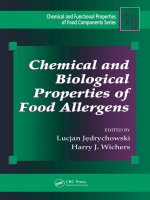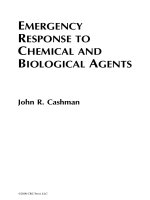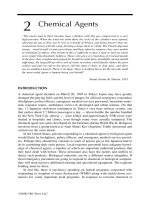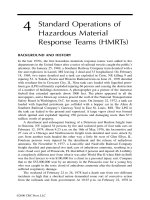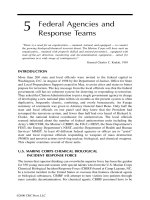Chemical and biological profile of Cespitularia species: A mini review
Bạn đang xem bản rút gọn của tài liệu. Xem và tải ngay bản đầy đủ của tài liệu tại đây (4.24 MB, 16 trang )
Journal of Advanced Research (2016) 7, 209–224
Cairo University
Journal of Advanced Research
MINI REVIEW
Chemical and biological profile of Cespitularia
species: A mini review
Abdelsamed I. Elshamy a,*, Mahmoud I. Nassar a, Tarik A. Mohamed b,
Mohamed-Elamir F. Hegazy b
a
Natural Compounds Chemistry Department, National Research Centre, 33 El Bohouth st., Dokki, Giza,
P.O. Box 12622, Egypt
b
Phytochemistry Department, National Research Centre, 33 El Bohouth st., Dokki, Giza, P.O. Box 12622, Egypt
G R A P H I C A L A B S T R A C T
This review furnishes an overview of all naturally isolated compounds, especially diterpenoids as well as biological activities of these species
such as anticancer, immunomodulatory, antiviral, antimicrobial, and anti-inflammatory activities.
* Corresponding author. Tel.: +20 1005525108; fax: +20 233370931.
E-mail address: (A.I. Elshamy).
Peer review under responsibility of Cairo University.
Production and hosting by Elsevier
/>2090-1232 ª 2015 Production and hosting by Elsevier B.V. on behalf of Cairo University.
210
A R T I C L E
A.I. Elshamy et al.
I N F O
Article history:
Received 31 May 2015
Received in revised form 27 July 2015
Accepted 28 July 2015
Available online 31 July 2015
Keywords:
Cespitularia
Terpenoids
Steroids
Anticancer
Anti-inflammatory
A B S T R A C T
Soft corals belonging to the genus Cespitularia have been well recognized as a rich source of
bioactive secondary metabolites especially diterpenoids. This review furnishes an overview of
all naturally isolated compounds from Cespitularia genus as, diterpenoids, nitrogencontaining diterpenes, sesquiterpenoids and steroids as well as biological activities of these species. Cespitularia species have been studied for their anticancer, immunomodulatory, antiviral,
antimicrobial, and anti-inflammatory activities. This work is the first review published on this
topic.
ª 2015 Production and hosting by Elsevier B.V. on behalf of Cairo University.
Abdelsamed I. Elshamy, Researcher in
National Research Centre, Egypt. The
research experiences focused on isolation and
identification of phenanthrenes, flavonoids,
sterols, terpenes, coumarines, volatile oils,
ceramides from medicinal plants and marines
by different isolation and identification
methods such as structural elucidation by
modern techniques of spectroscopic analysis,
MS, HRMS, 1D and 2D NMR and X-ray.
Synthesis of derivatives of natural products. Bioactive assay in vivo and
in vitro of natural products against different diseases.
Mahmoud I. Nassar, Professor of Natural
Products Chemistry, National Research Centre, Egypt. His research experiences focused
on isolation, identification of phenanthrenes,
flavonoids, sterols, coumarines, volatile oils,
and ceramides from medicinal plants and
marines. Bioactive evaluation of natural
products such as plant extracts and compounds.
Tarik A. Mohamed, Researcher in National
Research Centre, Egypt. His research interest
focused on Chemical Constituents of
Medicinal Plants and Marine Organisms,
Extraction, Isolation and Purification of
Natural Bioactive Compounds, Structural
Elucidation of Natural Products by Modern
Techniques of Spectroscopic Analysis, MS,
HRMS, 1D and 2D NMR and X-ray analysis,
Biological Activities of Natural Products
against different common diseases and Biotransformation for Natural
Compounds.
Mohamed-Elamir F. Hegazy, Associate Professor in Chemistry of Medicinal plant
Department, National Research Center, who
has two Ph.D. degrees: A Ph.D. degree from
Hiroshima University, Japan, and a Ph.D.
degree from Minia University, Egypt. Dr.
Hegazy is working in the field of natural
products chemistry and biotransformation of
natural compounds with cultured plant cells
ten years ago and he had a strong experience
in the isolation, purification and identification of natural compounds
from medicinal plants and marine organisms using high technique for
identification (1D and 2D NMR analysis).
Introduction
Marine organisms have developed a variety of bioactive secondary metabolites [1]. Chemically, the bioactive metabolites
isolated from marine animals could be divided into steroids,
terpenoids, isoprenoids, nonisoprenoids, quinones, halogenated compounds, nitrogen heterocyclics, and nitrogen sulfur heterocyclics [2–5]. The bioactive metabolites that are
adjectives of that kind of interest have been mainly isolated
from corals, marine sponges, jellyfish, sea anemones, bryozoans, molluscs, echinoderms, tunicates and crustaceans [3].
Octocorals (phylum Cnidaria) have been widely studied, as
they are responsible for the production of a huge array of
skeletal different classes of secondary metabolites. Family
Xeniidae (order Alcyonacea) which involves 17 genera of soft
corals such as Heteroxenia, Cespitularia, Xenia, Anthelia,
Asterospicularia, Bayerxenia, Sympodium, is a very large family
distributed in all over the marine environments [6,7].
Chemistry and bioactivities of Cespitularia species
Fig. 1
211
Photographs of some Cespitularia species.
Cespitularia genus involves almost 18 species such as
C. erecta, C. hypotentaculata, C subviridus, C. taeniata,
C. infirmata [8] (Fig. 1). They live in tropical reefs, in areas
with strong currents and with good light intensity like in the
Indo-Pacific Ocean from the East African coast to Australia,
New Guinea and southern Japan [8].
Several biological studies on different extracts and isolated
secondary metabolites from Cespitularia species have reported
activities such as anticancer, immunomodulatory, antiviral,
antimicrobial, and anti-inflammatory [9–11]. Soft corals of
the genus Cespitularia are rich in novel and diverse chemical
structures with interesting biological activities [12]. Reports
related metabolites chemistry of the genus Cespitularia is
scarce. Earlier studies of the genus Cespitularia led to the isolation of a diverse array of diterpenoids including alcyonolides,
caryophyllanoids, cembranolides, cespitularanoids, dolabellanoids, norverticillanoids, verticillanoids, and xenicanoids
[3,9–30].
Biological activities of Cespitularia species
Anticancer activity
It was reported that some isolated compounds from C. taeniata have significant cytotoxic activity. Cespitulactone A (60)
exhibited significant cytotoxicity against human cervical
epithelioid carcinoma (HeLa) and colon adenocarcinoma
(DLD-1) cancer cells with IC50 of 3.69 and 9.98 lg/ml, respectively. Flaccidoxide-13-acetate (62) showed mild activity
against human medulloblastoma (Daoy) and colon (WiDr)
cancer cells 16.9 and 13.8 lg/ml, respectively [10,16].
Cheng et al. [14] have reported that some isolated sesquiterpene lactams from EtOH extract of the soft coral C taeniata
exhibited cytotoxic activity. 8b-methoxyatractylenolide (83)
was also reported to exhibit cytotoxicity against KB and Daoy
cancer cell lines with ED50 values of 10.71 and 7.93 lg/ml
[14,17].
Some isolated cespitulactams from C. taeniata have been
reported to exhibit significant cytotoxicity against some human
cancer cells. Cespitulactam A (19) was reported to exhibit significant cytotoxicity against human Widr and Daoy cancer
cells with the IC50 values of 2.72 and 6.34 lg/ml, respectively
[18]. Duh et al. [9] have reported that some of isolated cespitularin derivatives showed cytotoxic activity against A-549; P388 and HT-29. Cespitularin B (33) and D (35) showed moderate cytotoxicity against P-388 cells with ED50 values of
3.23 and 3.86 lg/ml respectively. Cespitularin C (34) was stated to exhibit potent cytotoxicity against P-388 and A-549 cells
at ED50 values of 0.12 and 0.01 lg/ml respectively while cespitularin E (36) exhibits potent cytotoxicity against A-549 cells at
ED50 value of 0.034 lg/ml [9].
Shen et al. [19], stated that some isolated cespihypotin diterpene derivatives showed significant cytotoxic activity against
human Daoy and WiDr tumor cell lines. Cespihypotin T
(18), a Cespitularia norditerpene with a keto and two adjacent
hydroxy groups, showed significant cytotoxic activity against
human tumor cells exhibited significant cytotoxicity against
Daoy and WiDr cell lines with ED50 values of 9.3 and
7.5 lg/ml, respectively [19].
Some of nitrogen-containing verticillene diterpenoids from
the soft coral C. taeniata were reported to exhibit in vitro antitumor activity against human oral epidermoid carcinoma (KB)
and murine L1210 leukemia tumor cell lines. Cespitulactam K
(31) was stated to have a significant in vitro cytotoxic activity
against both human cancer cell lines at 3.7 and 5.1 lg/ml
respectively [12].
Duh et al. [11] reported that some isolated cespitularin
diterpenoids and secosteroids exhibited cytotoxic activity. It
was stated that cespitularin O (47) showed cytotoxicity against
P-388 cells with ED50 value of 3.4 lg/ml. While 3b,11dihydroxy-5b,6b-epoxy-9,11-secocholestan-9-one (83) exhibited cytotoxicity against HT-29 cells with an ED50 of 1.0 lg/ml
[11]. Some of reported cespitularines and cespihypotins from
C. hypotentaculata have exhibited cytotoxicity against leukemia (P-388 and A-549) cells [9,11,18,20]. Recently, Roy et al.
[29] stated that the two alcyonolide derivatives, trisnorditerpenoid 1 (72) and 2 (73), showed cytotoxicity against
HCT116 cancer cells with the IC50 values of 6.04 and
47.0 lM, respectively, and a dose dependent [21].
Recently, Lin et al. [15] stated that the isolated diterpenoid
from CH2Cl2/EtOH extract of C. taeniata, cespitulon A (74),
exhibited significant cytotoxicity against human medulloblastoma and colon adenocarcinoma cancer cells with IC50 values
212
Table 1
A.I. Elshamy et al.
Diterpenoids of Cespitularia species.
Source
Structure
C. hypotentaculata [11,24]
Compd. name
1: Cespihypotin A
O
O
H
OH
O
H
2: Cespihypotin B
O
H
OAc
O
O
H
3: Cespihypotin C
O
O
OH
H
4: Cespihypotin D
O
O
H
5: Cespihypotin E
O
CH3
O
O
OH
H
C. hypotentaculata [20]
O
O
O
6: Cespihypotin F
H
OH
RO
O
O
H
O
7: R‚H – Cespihypotin G
8: R‚COCH‚CH2 – Cespihypotin H
9: R‚Ac – Cespihypotin I
Chemistry and bioactivities of Cespitularia species
Table 1
213
(continued)
Source
Structure
Compd. name
10: Cespihypotin J
H
OAc
O
AcO
H
11: Cespihypotin K
O
HO
H
OH
O
O
12: Cespihypotin L
O
H
C. hypotentaculata [19]
R
R2
O
R1
13: R‚R1‚OMe, R2‚OH – Cespihypotin Q
14: R‚R2‚OMe, R1‚H – Cespihypotin R
15: R‚O, R1‚R2‚OH – Cespihypotin V
H
O
MeO
16: Cespihypotin S
OH
O
O
H
17: Cespihypotin U
H
O
O
H
OH
O
H
HO
O
HO
18: Cespihypotin T
O
H
(continued on next page)
214
Table 1
A.I. Elshamy et al.
(continued)
Source
Structure
Compd. name
C. taeniata [20,16,25]
R2
N
O
R1
19: R1‚OH, R2‚H – Cespitulactam A
20: R1‚R2‚OH – Cespitulactam C
21: R1‚OAc, R2‚H – Cespitulactam Amonoacetate
22: R1‚R2‚OAc – Cespitulactam A-diacetate
23: R1‚H, R2‚H – Cespitulactam B
H
R1
R2
N
O
OR3
24: R1‚R2‚R3‚H – Cespitulactam D
25: R1‚R2‚H, R3‚Ac – Cespitulactam E
26: R1‚R3‚H, R2‚OH – Cespitulactam F
27: R1‚CH2CH3, R2‚OH, R3‚H –
Cespitulactam G
28: R1‚CH3, R2‚R3‚H – Cespitulactam H
H
29: Cespitulactam I
H
N
O
O
OH
H
30: Cespitulactam J
C. taeniata [12]
H
N
O
NH
OH
H
31: Cespitulactam K
OH
O
N
OH
H
H
C. hypotentaculata and C. taeniata [9,12]
O
R
H
32: R‚OH – Cespitularin A
33: R‚H – Cespitularin B
Chemistry and bioactivities of Cespitularia species
Table 1
215
(continued)
Source
Structure
Compd. name
34: Cespitularin C
HO
H
C. hypotentaculata and C. taeniata
[9,12,20,24]
35: Cespitularin D
OH
O
O
OH
H
36: Cespitularin E
O
OH
H
H
R
O
HO
37:
38:
39:
40:
R‚OH – Cespitularin F
R‚OAc – 6-O-acetylcespitularin F
R‚H – Cespitularin G
R‚O – Cespitularin H
H
R
H
O
R1
41: R‚OH, R1‚O – Cespitularin I
42: R‚OAc, R1‚a-OH – Cespitularin J
43: R‚OAc, R1‚O –Cespitularin K
H
C. hypotentaculata [11,22]
O
H
OH
44: Cespitularin L
O
HO
H
H
(continued on next page)
216
Table 1
A.I. Elshamy et al.
(continued)
Source
Structure
Compd. name
O
R
OH
45: R‚a-OH – Cespitularin M
46: R‚b-OH – Cespitularin N
OH
H
R
O
O
OH
47: R‚H – Cespitularin O
48: R‚OMe – Cespitularin P
H
49: Cespitularin Q
O
OH
O
O
H
H
50: Cespitularin R
OAc
O
H
C. hypotentaculata [22]
51: Cespitularin S
OAc
O
O
OAc
H
C. taeniata [25]
HO
O
R
O
OH
52:
53:
54:
55:
R‚a-OH – Cespitulin A
R‚b-OH – Cespitulin B
R‚a-OEt – Cespitulin C
R‚b-OEt – Cespitulin D
H
C. taeniata [26]
56: Cespitulin E
O
OH
OH
Chemistry and bioactivities of Cespitularia species
Table 1
217
(continued)
Source
Structure
Compd. name
O
HO
57: Cespitulin F
O
H
O
H
OH
58: Cespitulin G
OH
O
O
OAc
H
59: Cespitolide
C. hypotentaculata [22,24]
H
O
O
O
H
OAc
60: R‚H – Cespitulactone A
61: R‚Bz – Cespitulactone B
O
H
O
O
OR
H
62: Flaccidoxide-13-acetate
AcO
OAc
O
63: 4b,5b-epoxyxeniaphylla-8(19),14-diene
C. sp [28]
H
H
O
(continued on next page)
218
Table 1
A.I. Elshamy et al.
(continued)
Source
Structure
Compd. name
64: Sarcophytol A
C. erecta [29]
OH
C. erecta [29]
65
H
O
O
H
H
C. sp [21]
66
H
OCH3
O
O
H
O
O
67
H
OCH3
O
O
H
O
O
68
H
OCH 3
O
O
H
O
C. sp [21]
O
69
HOO
H
OCH 3
O
O
H
O
O
Chemistry and bioactivities of Cespitularia species
Table 1
219
(continued)
Source
Structure
Compd. name
70
OOH
H
OCH 3
O
O
H
O
O
71: Alcyonolide
H
O
O
H
O
H
H
O
O
O
72: Trisnorditerpenoid 1
C. sp [21,29]
O
H
O
H
H
O
H
H
O
O
73: Trisnorditerpenoid 2
O
H
O
H
O
H
H
O
O
O
C. taeniata (15)
74: Cespitulone A
O
HO
O
OH
HO
H
(continued on next page)
220
Table 1
A.I. Elshamy et al.
(continued)
Source
Structure
Compd. name
75: Cespitulone B
O
HO
OH
HO
O
H
Table 2
Sesquiterpenoids of Cespitularia species.
Source
Structure
Compd. name
C. aff. subviridis [23,27]
76: (+)Palustrol
OH
H
77: (À)Alloaromadendrene
HO
78: (À)Viridiflorol
H
H
79: (+)Ledol
HO
C. taeniata [14]
R
80: R‚H – Taenialactam A
81: R‚OH – Taenialactam B
H
N
O
H
R
82: R‚a-Me – Taenialactone A
83: R‚b-Me – 8b-methoxyatractylenolide
OMe
O
O
H
84: Atractylenolactam
H
N
O
H
C. sp [26,30]
85: Trinorsesquiterpene
Chemistry and bioactivities of Cespitularia species
221
of 8.7 and 6.7 lM, respectively by a comparison with a positive
control with IC50 at 0.3 lM [15].
33.8 ± 4.1% inhibition, respectively) with the use of genistein
as a positive control [26].
Immunomodulatory and antiviral activities
Antimicrobial activity
Some isolated cespihypotin diterpenes from C. hypotentaculata
have exhibited weak antiviral activity. Cespihypotin K (11)
showed significant enhancement of cell proliferation, while
cespihypotin L (12) exhibited inhibition on peripheral blood
mononuclear cells (PBMC) proliferation induced by phytohemagglutinin (PHA). The antiviral activities of these compounds were achieved by a comparison with the positive
control, cyclosporine A [20].
Some of the isolated nitrogen-containing verticillene diterpenoids isolated from the Taiwanese soft coral C. taeniata
were reported to exhibit a antimicrobial activity [12]. Cespitulactam G (27) was stated to exhibit potent antimicrobial activity against Trichophyton mentagrophytes (IFM45110) with an
MIC value of 2.08 lg/ml. Cespitulactam D (24), cespitulactam
J (30), and cespitulactam K (31) were reported to have significant antimicrobial activity against M. luteus (IFM2066) and
C. neoformans (IFM46914) (6–8) and T. mentagrophytes (2
and 7) with MIC value of 4.16 lg/ml [12,20]
Anti-inflammatory activity
Some isolated compounds from C. hypotentaculata were
reported to have a significant anti-inflammatory activity
in vitro. Cespitularin F (37), cespitularines I (41) and cespitularin S (51) showed significant inhibition of iNOS protein
expression [21]. Roy et al. [29] stated that the two alcyonolide
derivatives, trisnorditerpenoid 1 (72) and 2 (73), showed antiinflammatory effect in LPS/IFN-c-stimulated inflammatory
RAW 264.7 macrophage cells and showed anti-inflammatory
activity in low concentrations and a dose dependent of 2–
8 lM. The lack of cytotoxicity against RAW 264.7 macrophage cells in the test concentration range indicated that inhibition of nitric oxide production was due to the effects of these
compounds [21].
The isolated compounds from C. taeniata, cespitulins E–G
(56–58) were reported to have inhibitory effects of superoxide
anion generation and elastase release by human neutrophils in
response to FMLP/CB. Cespitulin G (56) exhibited significant
inhibitory activity against elastase release with an IC50 value of
2.7 lg/ml and inhibition of superoxide anion with an IC50
value of 6.2 lg/ml. Cespitulin E (58) exhibited moderate activities at the concentration of 10 lg/ml (30.6 ± 6.0 and
Table 3
Chemical constituents of Cespitularia species
Soft corals of the genus Cespitularia are rich in novel and
diverse chemical structures with interesting biological activities.
This genus elaborates varied diterpenoids of cembrane,
neodolabellane, cespitularane, and verticillane skeleton [9–
21]. Few numbers of sesquiterpenes were also reported [23].
The previously isolated diterpenoids, sesquiterpenoids and steroids from Cespitularia species are summarized in Tables 1–3.
Diterpenoids
Marine invertebrates are a rich source of structurally unique
terpenoids with interesting biological activities. The biological
activity of some isolated Cespitularia diterpenoids has demonstrated remarkable cytotoxicity against various cancer cell
lines. Several chemical studies on the Cespitularia species led
to the isolation of a diverse array of diterpenoids as shown
in Table 1, including alcyonolides, caryophyllanoids, cembranolides, cespitularanoids, dolabellanoids, norverticillanoids,
verticillanoids, and xenicanoids.
Steroids of Cespitularia species.
Source
Structure
Compd. Name
C. hypotentaculata [12,37]
86: 3b,11-dihydroxy-5b,6b-epoxy-9,11-secocholestan-9-one
HO
O
HO
O
87: 3b,11-dihydroxy-5b,6b-epoxy-9,11-secogorgostan-9-one
HO
O
HO
O
222
A.I. Elshamy et al.
Fig. 2
Biogenetic pathways of Cespitularia diterpenoids.
Biogenetic pathways of Cespitularia diterpenoids
The Cespitularia species are characterized with a special type
of diterpenoids such as cespitularia, cespihypotin, cespitulactam, cespitularin, and cespitulons. The biogenetic pathways
of these diterpenoids were described in few reports [15,16].
The biogenetic pathways of Cespitularia diterpenoids, as
shown in Fig. 2, were derived from the starting amino acid geranylgeranyl diphosphate (GGDP). The amino acid (GGDP)
was enzymatically converted by cyclization to 1S-verticillene
that might be the main precursor of all Cespitularia diterpenoids. Firstly, cespitularin C, a basic diterpenoid for biogenesis of Cespitularia diterpenoids, was synthesized from 1Sverticillene via biogenetically rearrangement. Then cespitularin
Chemistry and bioactivities of Cespitularia species
C was biogenetically rearranged to give the intermediate a that
could be converted to different Cespitularia diterpenes such as
cespitularin, cespihypotin and cespitulactams [16,19,20,26].
Sesquiterpenoids
A few reported sesquiterpenoids were identified from Cespitularia species that include sesquiterpenoids, N-containing
sesquiterpenes (sesquiterpene lactams), and sesquiterpene lactones (Table 2). Cheng et al. [10] stated the biogenesis of the
Cespitularia sesquiterpenoids starting by (E,E)-Farnesyl cation
[10].
Steroids
Soft corals belonging to family Xeniidae have been shown to
be an extraordinarily rich source of sterols displaying unconventional nuclear structures and side chains, as well as unusual
oxygenation patterns of the A-D rings such as petrosterols
[31], gorgosterols [32], cholesterols, ergosterols [33,34] and secosteroids [35–37]. The first marine secosteroid to be described
was encountered in the gorgonian Pseudopterogorgia americana in 1972 [36]. Cespitularia species are not rich soft corals
with steroids. Only two cytotoxic 9,11-secosteroids were isolated from C. hypotentaculata [11].
Conclusions
Cespitularia species (family Xeniidae) are interesting marine
organisms as rich sources in novel and diverse chemical structures such as terpenoids and steroids. These species are characterized by special types of diterpenoids that may be named
Cespitularia diterpenoids such as cespitulins, cespitularines,
cespitulactams, cespitulactones and cespihypotins. As well as
Cespitularia species are characterized by a very rare type of
sesquiterpene lactams. Biologically, Cespitularia species produce novel secondary metabolites with very interesting biological activities especially anticancer activity.
Conflict of Interest
The authors have declare no conflict of interest.
Compliance with Ethics Requirements
This article does not contain any studies with human or animal
subjects.
References
[1] Faulkner D. Marine natural products. Nat Prod Rep 2001;18:1.
[2] Faulkner D. Marine natural products. Nat Prod Rep
1990;7:613.
[3] Bhakuni DS, Rawat DS. Bioactive Marine Natural
Products. New Delhi, India: Anamaya Publishers; 2005.
[4] Scheuer PJ. Marine Natural Products, Chemical and Biological
Perspectives, vol. 4. New York: Academic Press; 1980.
[5] Scheuer PJ. Marine Natural Products, Chemical and Biological
Perspectives, vol. 5. New York: Academic Press; 1983.
223
[6] Van-Ofwegen L. ‘‘Xeniidae’’ World register of marine species.
Retrieved January 29, 2012.
[7] Borneman EH. Aquarium corals. Selection, husbandry and
natural history 2001–2009. TFH Publications; 2009. p. 145–53.
[8] Van-Ofwegen L. Cespitularia Milne-Edwards & Haime
2013:1850.
[9] Duh CH, El-Gamal AA, Chiang CY, Chu CJ, Wang SK, Dai
CF. Novel terpenoids from the formosan soft coral Cespitularia
hypotentaculata. J Nat Prod 2002;65:1429–33.
[10] Cheng JY, El-Razek MHA, Shen YC. Verticillane and
norverticillane diterpenoids from the formosan soft coral
Cespitularia hypotentaculata. Helv Chim Acta 2009;92:2146–54.
[11] Duh CY, Li CH, Wang SK, Dai CF. Diterpenoids,
Norditerpenoids, and secosteroids from the Formosan soft
coral Cespitularia hypotentaculata. J Nat Prod 2006;69:1188–92.
[12] Shen YC, Cheng Y, Kobayashi J, Kubota T, Takahashi Y,
Mikami Y, et al. Nitrogen-containing verticillene diterpenoids
from the Taiwanese soft coral Cespitularia taeniata. J Nat Prod
2007;70:1961–5.
[13] Bowden BF, Coll JC, Gulbis JM, Mackay MF, Willis RH.
Studies of Australian soft corals. XXXVIII. Structure
determination of several diterpenes derived from a Cespitularia
species (Coelenterata, Octocorallia, Xeniidae). Aust J Chem
1986;39:803–12.
[14] Cheng Y, Chen C, Kuo Y, Shen Y. New nitrogen-containing
sesquiterpenoids from the Taiwanese soft coral cespitularia
taeniata MAY. Chem Biodiversity 2009;6:1266–72.
[15] Lin Y, Wang S, Chen C, Kuo Y, Shen Y. Cespitulones A and B,
cytotoxic diterpenoids of a new structure class from the soft
coral Cespitularia taeniata. Marine Drugs 2014;12:3477–86.
[16] Shen Y, Ho C, Kuo Y, Lin Y. Cespitulactones A and B, new
diterpenoids from Cespitularia taeniata. Bioorg Med Chem Lett
2005;16(9):2369–72.
[17] Cheng ZL, Cao WY, Zhou GX, Wichtl M. A sesquiterpene
lactam from Artractylodes macrocephala. Phytochemistry
1997;45(4):765–7.
[18] Shen YC, Lin Y, Kuo YS, Cheng Y. Cespitulactams A, B, and
C, three new nitrogen-containing diterpenes from Cespitularia
taeniata May. Tetrahedron Lett 2005;46:7893–7.
[19] Shen YC, Lo KL, Kuo YS, Kuo YC, Chen YC, Khalil AT.
Cespihypotin Q-V, verticillene diterpenoids from Cespitularia
hypotentaculata. J Nat Prod 2008;71:1993–7.
[20] Shen YC, Wu YR, Lin JJ, Lo KL, Kuo YC, Khalil AT. Eight
new diterpenoids from soft coral Cespitularia hypotentaculata.
Tetrahedron 2007;63:10914–20.
[21] Roy KP, Maarisit W, Roy MC, Taira J, Ueda K. Five new
diterpenoids from an Okinawan soft coral, Cespitularia sp..
Marine Drugs 2012;10:2741–8.
[22] Cheng S, Lin E, Wen Z, Chiang M, Duh C. Two new
verticillane-type diterpenoids from the formosan soft coral
Cespitularia hypotentaculata. Chem Pharm Bull 2010;47:6651–5.
[23] Braekmann JC, Daloze D, Ottinger R, Tursch B. Chemical
studies of marine invertebrates. XXVII. On the absolute
configuration of aromadendrane sesquiterpenes from the soft
coral Cespitularia aff. Subviridis. Experientia 1977;33(8):993.
[24] Shen Y, Lin J, Wu Y, Cheng J, Duh C, Lo KL. New
norditerpenoids
from
Cespitularia
hypotentaculata.
Tetrahedron Lett 2006;47:6651–5.
[25] Lin Y, Fazary AE, Shen Y. Cespitulins A–D, novel diterpenoids
from Taiwanese Cespitularia taeniata. Tetrahedron Lett
2010;51:6654–7.
[26] Chang J, Fazary AE, Lin Y, Hwang T, Shen Y. New verticillane
diterpenoids from Cespitularia taeniata. Chem Biodivers
2012;9:654–61.
[27] Konig G, Wright A. A new caryophyllene-based diterpene from
the
soft
coral,
Cespitularia
sp..
J
Nat
Prod
1993;56(12):2198–200.
224
[28] Janairo JR, Janairo GC, Ragasa CY, Bowden BF. A marine
verticillane diterpenoid from Cespitularia erecta. Nat Prod Res
2008;22(1):48–52.
[29] Roy PK, Roy MC, Taira J, Ueda K. Structure and bioactivity of
a trisnorditerpenoid and a diterpenoid from an Okinawan soft
coral, Cespitularia sp.. Tetrahedron Lett 2014;55(8):1421–3.
[30] Bowden BF, Coll JC, Tapiolas DM. Studies of Australian soft
corals. XXX. A novel trisnorsesquiterpene from a Cespitularia
species and the isolation of guaiazulene from a small blue
Alcyonium species. Aust J Chem 1983;36:211–4.
[31] Tung NH, Minh CV, Ha TT, Kiem PV, Huong HT, Dat NT,
et al. C29 sterols with a cyclopropane ring at C-25 and 26 from
the Vietnamese marine sponge Ianthella sp. and their anticancer
properties. Bioorg Med Chem Lett 2009;19:4584–8.
[32] Elshamy AI, Abdel-Razik AF, Nassar MI, Mohamed TK,
Ibrahim MA, El-Kousy SM. A new gorgostane derivative from
the Egyptian Red Sea soft coral Heteroxenia ghardaqensis. Nat
Prod Res 2013;27(14):1250–4.
A.I. Elshamy et al.
[33] Baker BJ, Kerr RG. Biosynthesis of marine sterols. Top Curr
Chem 1993;167:1–31.
[34] Sjo¨strand U, Bohlin L, Fisher L, Colin M, Djerassi C. Minor
and trace sterols from marine invertebrates 28. A novel
polyhydroxylated sterol from the soft coral Anthelia glauca.
Steroids 1981;38(3):347–54.
[35] Sica D, Musumeci D. Secosteroids of marine origin. Steroids
2004;69:743–56.
[36] Enwall EL, van der Helm D, Hsu IN, Pattabhiraman T, Schmitz
FJ, Spraggins RL, Weinhrimer AJ. Crystal structure and
absolute configuration of two cyclopropane containing marine
steroids. J Chem Soc Chem Commun 1972;4:215–6.
[37] Hegazy MF, Mohamed TA, Alhammady MA, Shaheen AM,
Reda ER, Elshamy AI, et al. Molecular architecture and
biomedical leads of terpenes from red sea marine
invertebrates. Mar Drugs 2015;13:3154–81.



